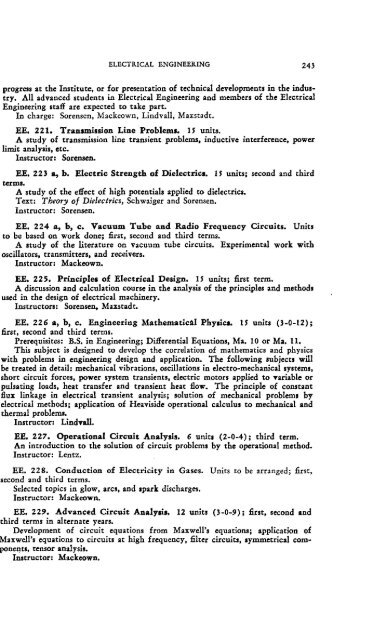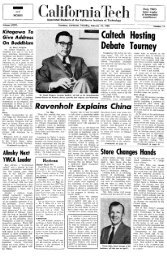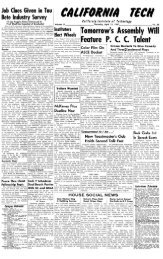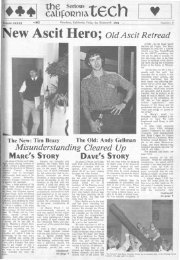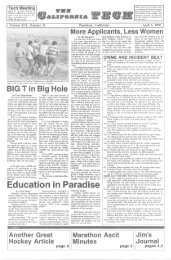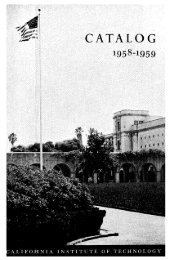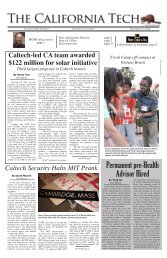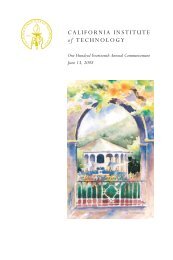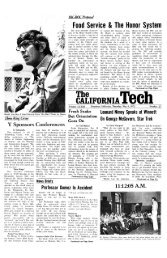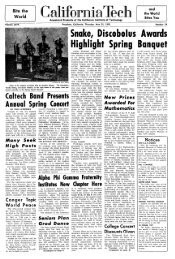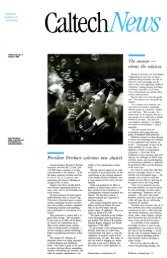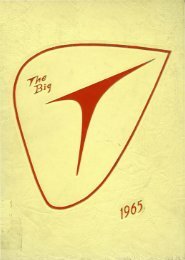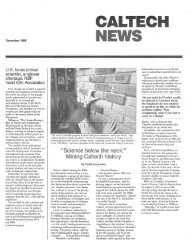PDF (1941) - CaltechCampusPubs
PDF (1941) - CaltechCampusPubs
PDF (1941) - CaltechCampusPubs
Create successful ePaper yourself
Turn your PDF publications into a flip-book with our unique Google optimized e-Paper software.
ELECTRICAL ENGINEERING 243<br />
progress at the Institute, or for presentation of technical developments in the industry.<br />
All advanced students in Electrical Engineering and members of the Electrical<br />
Engineering itaff are expected to take part.<br />
In charge: Sorensen, Mackeown, Lindvall, Maxst.dr..<br />
EE. 221. Transmission Line Problem.. 15 units.<br />
A study of transmission line transient problecns. inductive interference, power<br />
limit analysis, etc.<br />
Instructor: Sorensen.<br />
EE. 223 a, b. Electric Strength of Dielectric •• 15 units; second and third<br />
terms.<br />
A study of the effect of high potentials applied to dielectrics.<br />
Text: Theory of Dielectrics, Schwaiger and Sorensen.<br />
Instructor: Sorensen.<br />
EE. 224 a, b, c. Vacuum Tube and Radio Frequency Circuits. Units<br />
to be based on work done; first, second and third terms.<br />
A study of the literature on vacuum tube circuits. Experimental work with<br />
oscillators. transmitters. and receivers.<br />
Instructor: Mackeown.<br />
EE. 225. Principles of Electrical Design. 15 units; first term.<br />
A discussion and calculation course in the analysis of the principles and methods<br />
used in the design of electrical machinery.<br />
Instructors: Sorensen. Maxstade.<br />
EE. 226 a, b, c. Engineering Mathematic:lI Physic.. 15 units (3-0-12);<br />
first. second and third terms.<br />
Prerequisites: B.S. in Engineering; Differential Equations. Ma. 10 or Ma. 11.<br />
This subject is designed to develop the correlation of mathematics and physics<br />
with problems in engineering design and application. The following subjects will<br />
be treated in detail: mechanical vibrations, oscillations in electro-mechanical systems,<br />
short circuit forces. power system transients, electric motors applied to Tariable or<br />
pulsating loads, heat transfer and transient heat flow. The principle of constant<br />
flux linkage in electrical transient analysis; solution of mechanical problem. by<br />
electrical methods; application of Heaviside operational calculus to mechanical and<br />
thermal problems.<br />
Instructor: Lindvall.<br />
EE. 227. Operational Circuit Analysis. 6 units (2-0-4); third term.<br />
An introduction to the solution of circuit problems by the operational method.<br />
Instructor: Lentz.<br />
EE. 228. Conduction of Electricity in Gases. Units to be arranged; first,<br />
second and third terms.<br />
Selected topics in glow, arcs. and Ipark discharges.<br />
Instructor: Mackeown.<br />
EE. 229. Advanced Circuit Analysi.. 12 units (3-0-9); first. second and<br />
third terms in alternate years.<br />
Development of circuit equations from Maxwell's equations; application of<br />
axwell's equations to circuits at high frequency, filter circuits, symmetrical comonents,<br />
tensor analysis.<br />
Instructor: Mackeown.


